Abstract
1. We have recently found that diphenyleneiodonium (DPI), a novel inhibitor of nitric oxide (NO) synthase, causes pressor and tachycardic responses in pentobarbitone- but not halothane-anaesthetized rats. The present study investigated the mechanism by which halothane suppresses the pressor response of DPI. The effects of halothane on the pressor response of DPI were also compared with those of other anaesthetic agents. 2. In conscious rats, i.v. bolus injections of DPI (0.025- 1.6 mg kg-1) caused dose-dependent increases in mean arterial pressure (MAP), with ED90 of 0.07 +/- 0.01 mg kg-1 and maximal rise of MAP (Emax) of 59 +/- 2 mmHg. While ketamine potentiated Emax without altering the ED50 and pentobarbitone increased the ED50 without changing Emax of the pressor response to DPI, chloralose, urethane and ethanol displaced the curve to the right and potentiated Emax. In contrast, halothane (0.5-1.25%) dose-dependently and non-competitively reduced the pressor responses to DPI. 3. Intravenous bolus injection of a single dose of DPI (1.6 mg kg-1) caused immediate and large increases in plasma noradrenaline and adrenaline, as well as MAP in conscious rats. Halothane (1.25%) almost completely inhibited these increases. 4. The results suggest that DPI causes a pressor response in conscious rats by activating the sympathetic nervous system and halothane abolishes this pressor response by inhibiting activities of the sympathetic nervous system. The results also show that influences of anaesthetics must be taken into consideration when evaluating pressor response of vasoactive agents.
Full text
PDF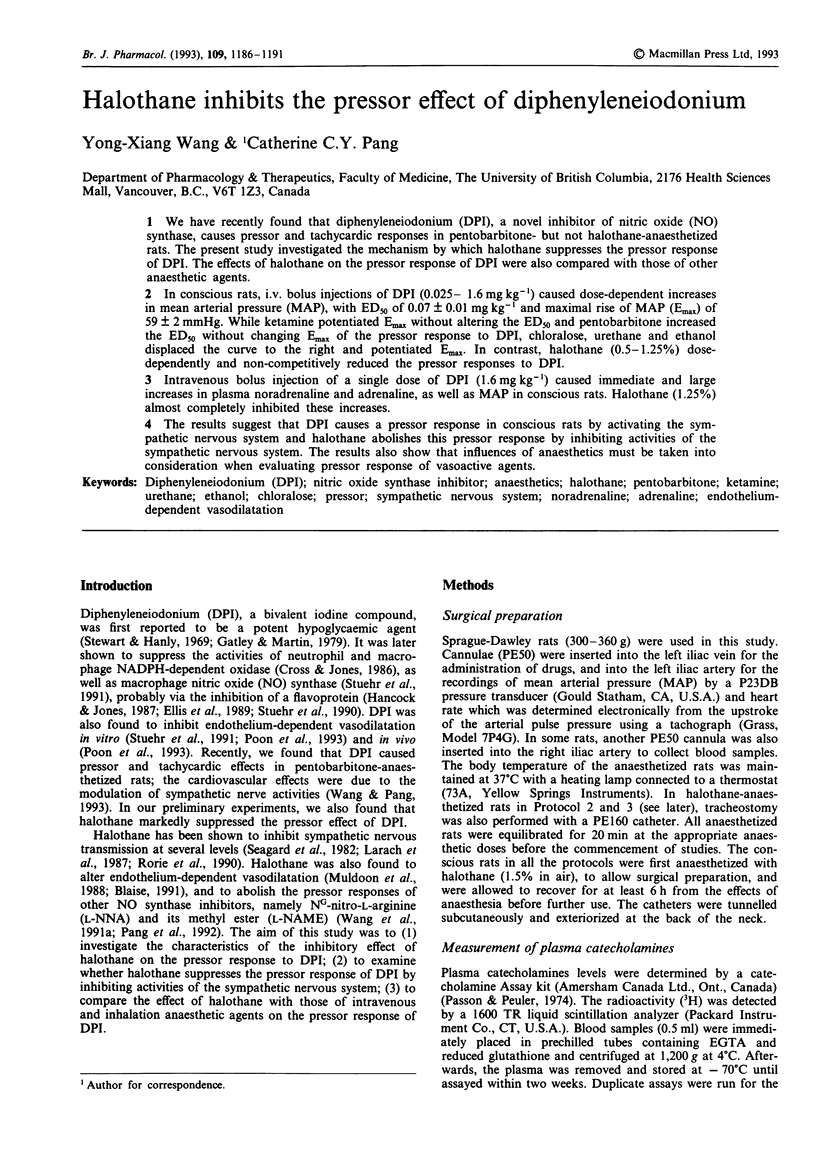
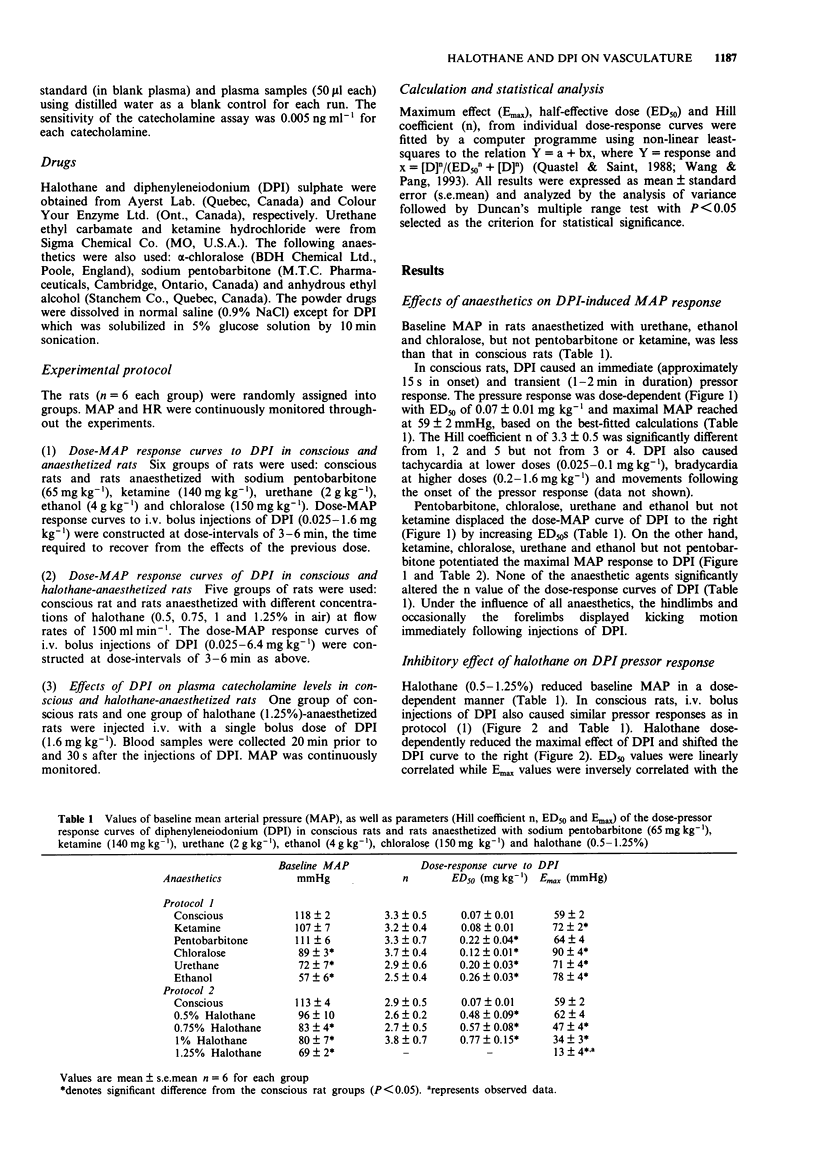
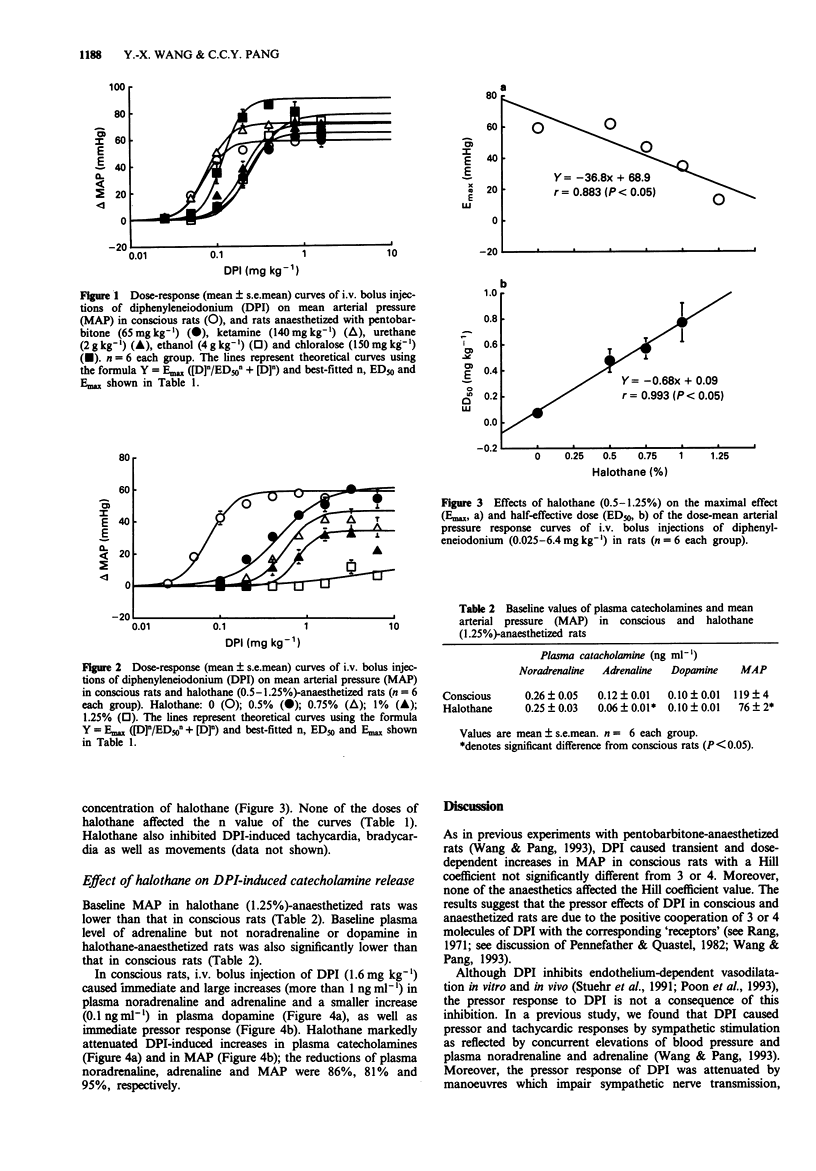
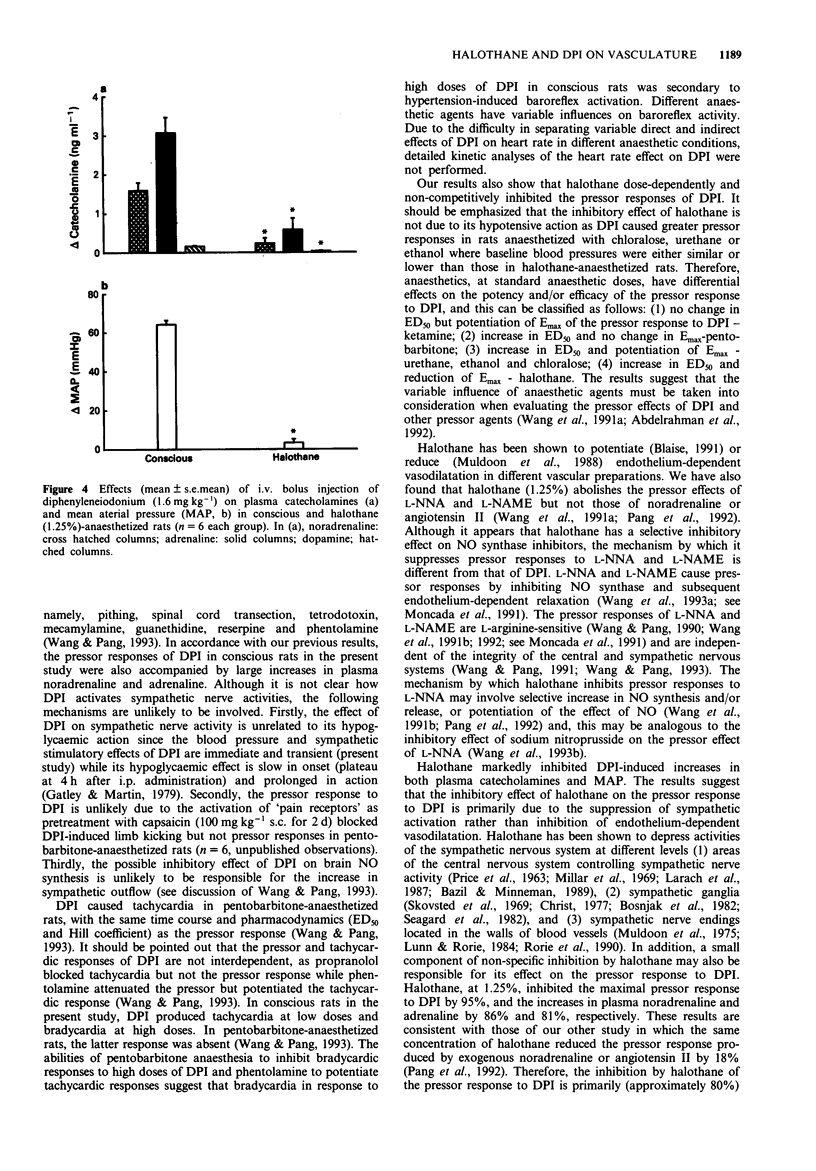

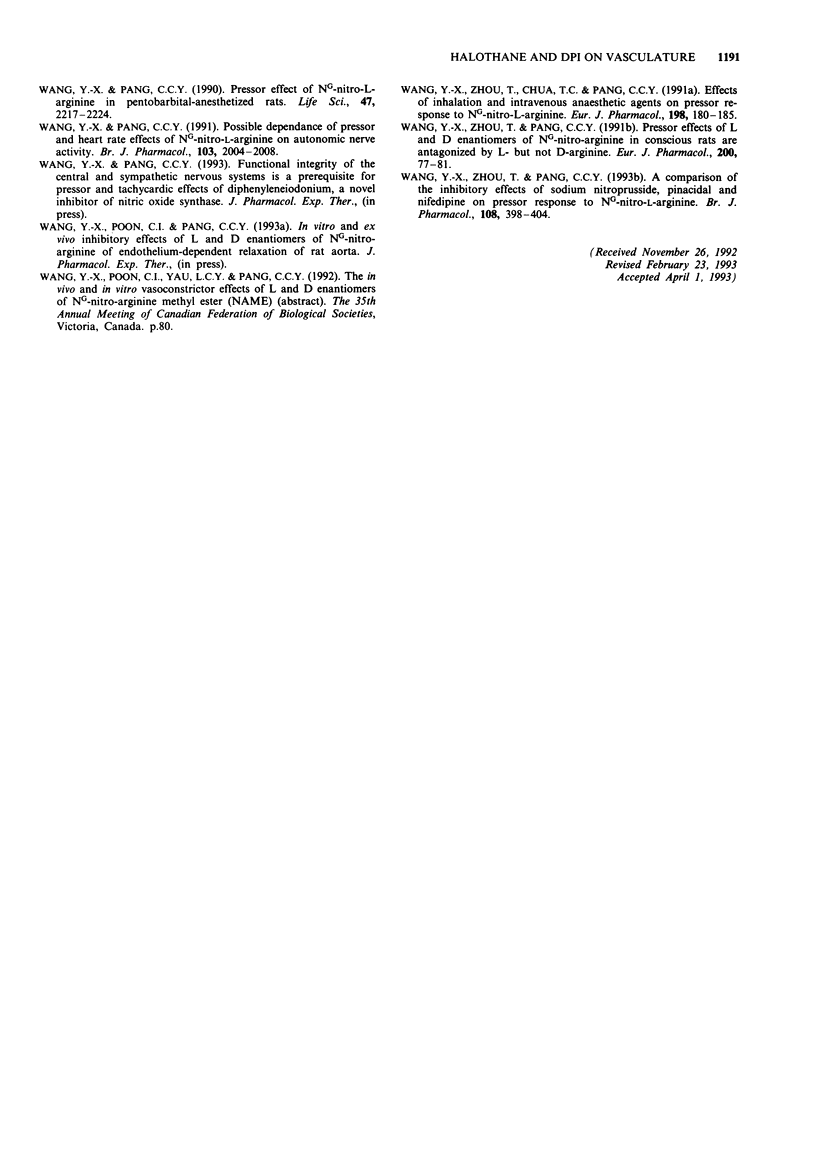
Selected References
These references are in PubMed. This may not be the complete list of references from this article.
- Abdelrahman A., Wang Y. X., Pang C. C. Effects of anaesthetic agents on pressor response to beta-blockers in the rat. J Pharm Pharmacol. 1992 Jan;44(1):34–38. doi: 10.1111/j.2042-7158.1992.tb14359.x. [DOI] [PubMed] [Google Scholar]
- Bazil C. W., Minneman K. P. Clinical concentrations of volatile anesthetics reduce depolarization-evoked release of [3H]norepinephrine, but not [3H]acetylcholine, from rat cerebral cortex. J Neurochem. 1989 Sep;53(3):962–965. doi: 10.1111/j.1471-4159.1989.tb11799.x. [DOI] [PubMed] [Google Scholar]
- Blaise G. A. Effect of volatile anesthetic agents on endothelium-dependent relaxation. Adv Exp Med Biol. 1991;301:229–235. doi: 10.1007/978-1-4684-5979-1_21. [DOI] [PubMed] [Google Scholar]
- Bosnjak Z. J., Seagard J. L., Wu A., Kampine J. P. The effects of halothane on sympathetic ganglionic transmission. Anesthesiology. 1982 Dec;57(6):473–479. doi: 10.1097/00000542-198212000-00007. [DOI] [PubMed] [Google Scholar]
- Christ D. Effects of halothane on ganglionic discharges. J Pharmacol Exp Ther. 1977 Feb;200(2):336–342. [PubMed] [Google Scholar]
- Clanachan A. S., McGrath J. C. Effects of ketamine on the peripheral autonomic nervous system of the rat. Br J Pharmacol. 1976 Oct;58(2):247–252. doi: 10.1111/j.1476-5381.1976.tb10402.x. [DOI] [PMC free article] [PubMed] [Google Scholar]
- Cross A. R., Jones O. T. The effect of the inhibitor diphenylene iodonium on the superoxide-generating system of neutrophils. Specific labelling of a component polypeptide of the oxidase. Biochem J. 1986 Jul 1;237(1):111–116. doi: 10.1042/bj2370111. [DOI] [PMC free article] [PubMed] [Google Scholar]
- Ellis J. A., Cross A. R., Jones O. T. Studies on the electron-transfer mechanism of the human neutrophil NADPH oxidase. Biochem J. 1989 Sep 1;262(2):575–579. doi: 10.1042/bj2620575. [DOI] [PMC free article] [PubMed] [Google Scholar]
- Gatley S. J., Martin J. L. Some aspects of the pharmacology of diphenyleneiodonium, a bivalent iodine compound. Xenobiotica. 1979 Sep;9(9):539–546. doi: 10.3109/00498257909042319. [DOI] [PubMed] [Google Scholar]
- Hancock J. T., Jones O. T. The inhibition by diphenyleneiodonium and its analogues of superoxide generation by macrophages. Biochem J. 1987 Feb 15;242(1):103–107. doi: 10.1042/bj2420103. [DOI] [PMC free article] [PubMed] [Google Scholar]
- Larach D. R., Schuler H. G., Derr J. A., Larach M. G., Hensley F. A., Jr, Zelis R. Halothane selectively attenuates alpha 2-adrenoceptor mediated vasoconstriction, in vivo and in vitro. Anesthesiology. 1987 Jun;66(6):781–791. doi: 10.1097/00000542-198706000-00012. [DOI] [PubMed] [Google Scholar]
- Lunn J. J., Rorie D. K. Halothane-induced changes in the release and disposition of norepinephrine at adrenergic nerve endings in dog saphenous vein. Anesthesiology. 1984 Oct;61(4):377–384. doi: 10.1097/00000542-198410000-00004. [DOI] [PubMed] [Google Scholar]
- Millar R. A., Warden J. C., Cooperman L. H., Price H. L. Central sympathetic discharge and mean arterial pressure during halothane anaesthesia. Br J Anaesth. 1969 Nov;41(11):918–928. doi: 10.1093/bja/41.11.918. [DOI] [PubMed] [Google Scholar]
- Moncada S., Palmer R. M., Higgs E. A. Nitric oxide: physiology, pathophysiology, and pharmacology. Pharmacol Rev. 1991 Jun;43(2):109–142. [PubMed] [Google Scholar]
- Muldoon S. M., Hart J. L., Bowen K. A., Freas W. Attenuation of endothelium-mediated vasodilation by halothane. Anesthesiology. 1988 Jan;68(1):31–37. doi: 10.1097/00000542-198801000-00006. [DOI] [PubMed] [Google Scholar]
- Nedergaard O. A. Cocaine-like effect of ketamine on vascular adrenergic neurones. Eur J Pharmacol. 1973 Aug;23(2):153–161. doi: 10.1016/0014-2999(73)90051-4. [DOI] [PubMed] [Google Scholar]
- PRICE H. L., LINDE H. W., MORSE H. T. CENTRAL NERVOUS ACTIONS OF HALOTHANE AFFECTING THE SYSTEMIC CIRCULATION. Anesthesiology. 1963 Nov-Dec;24:770–778. doi: 10.1097/00000542-196311000-00004. [DOI] [PubMed] [Google Scholar]
- Passon P. G., Peuler J. D. A simplified radiometric assay for plasma norepinephrine and epinephrine. Anal Biochem. 1973 Feb;51(2):618–631. doi: 10.1016/0003-2697(73)90517-4. [DOI] [PubMed] [Google Scholar]
- Pennefather P., Quastel D. M. Fast desensitization of the nicotinic receptor at the mouse neuromuscular junction. Br J Pharmacol. 1982 Nov;77(3):395–404. doi: 10.1111/j.1476-5381.1982.tb09311.x. [DOI] [PMC free article] [PubMed] [Google Scholar]
- Quastel D. M., Saint D. A. Transmitter release at mouse motor nerve terminals mediated by temporary accumulation of intracellular barium. J Physiol. 1988 Dec;406:55–73. doi: 10.1113/jphysiol.1988.sp017368. [DOI] [PMC free article] [PubMed] [Google Scholar]
- Rang H. P. Drug receptors and their function. Nature. 1971 May 14;231(5298):91–96. doi: 10.1038/231091a0. [DOI] [PubMed] [Google Scholar]
- Richter J. A., Holtman J. R., Jr Barbiturates: their in vivo effects and potential biochemical mechanisms. Prog Neurobiol. 1982;18(4):275–319. doi: 10.1016/0301-0082(82)90013-2. [DOI] [PubMed] [Google Scholar]
- Rorie D. K., Hunter L. W., Lunn J. J. Halothane decreases the release of neuropeptide Y and 3,4-dihydroxyphenylglycol from superfused segments of dog pulmonary artery. Anesthesiology. 1990 Oct;73(4):722–730. doi: 10.1097/00000542-199010000-00019. [DOI] [PubMed] [Google Scholar]
- Seagard J. L., Hopp F. A., Donegan J. H., Kalbfleisch J. H., Kampine J. P. Halothane and the carotid sinus reflex: evidence for multiple sites of action. Anesthesiology. 1982 Sep;57(3):191–202. doi: 10.1097/00000542-198209000-00008. [DOI] [PubMed] [Google Scholar]
- Skovsted P., Price M. L., Price H. L. The effects of halothane on arterial pressure, preganglionic sympathetic activity and barostatic reflexes. Anesthesiology. 1969 Dec;31(6):507–514. doi: 10.1097/00000542-196912000-00002. [DOI] [PubMed] [Google Scholar]
- Stuehr D. J., Fasehun O. A., Kwon N. S., Gross S. S., Gonzalez J. A., Levi R., Nathan C. F. Inhibition of macrophage and endothelial cell nitric oxide synthase by diphenyleneiodonium and its analogs. FASEB J. 1991 Jan;5(1):98–103. doi: 10.1096/fasebj.5.1.1703974. [DOI] [PubMed] [Google Scholar]
- Stuehr D. J., Kwon N. S., Nathan C. F. FAD and GSH participate in macrophage synthesis of nitric oxide. Biochem Biophys Res Commun. 1990 Apr 30;168(2):558–565. doi: 10.1016/0006-291x(90)92357-6. [DOI] [PubMed] [Google Scholar]
- Traber D. L., Wilson R. D. Involvement of the sympathetic nervous system in the pressor response to ketamine. Anesth Analg. 1969 Mar-Apr;48(2):248–252. [PubMed] [Google Scholar]
- Wang Y. X., Pang C. C. Possible dependence of pressor and heart rate effects of NG-nitro-L-arginine on autonomic nerve activity. Br J Pharmacol. 1991 Aug;103(4):2004–2008. doi: 10.1111/j.1476-5381.1991.tb12367.x. [DOI] [PMC free article] [PubMed] [Google Scholar]
- Wang Y. X., Pang C. C. Pressor effect of NG-nitro-L-arginine in pentobarbital-anesthetized rats. Life Sci. 1990;47(24):2217–2224. doi: 10.1016/0024-3205(90)90152-h. [DOI] [PubMed] [Google Scholar]
- Wang Y. X., Zhou T., Pang C. C. A comparison of the inhibitory effects of sodium nitroprusside, pinacidil and nifedipine on pressor response to NG-nitro-L-arginine. Br J Pharmacol. 1993 Feb;108(2):398–404. doi: 10.1111/j.1476-5381.1993.tb12816.x. [DOI] [PMC free article] [PubMed] [Google Scholar]
- Wang Y. X., Zhou T., Pang C. C. Pressor effects of L and D enantiomers of NG-nitro-arginine in conscious rats are antagonized by L- but not D-arginine. Eur J Pharmacol. 1991 Jul 23;200(1):77–81. doi: 10.1016/0014-2999(91)90668-g. [DOI] [PubMed] [Google Scholar]


